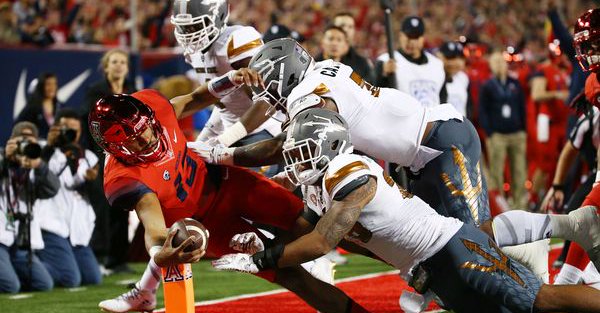By Justin Toscano
There will be many topics discussed by Pac-12 football coaches during the conference’s annual meetings at the Arizona Biltmore this week, but perhaps none more than recruiting.
The NCAA Division I Council in mid-April voted to alter the recruiting calendar, effective Aug. 1. The changes allow for an added December signing period before the traditional February National Signing Day.
Plus, instead of having to wait until their senior year, recruits will be able to take official visits starting April 1 of their junior year and ending on the Sunday before the last Wednesday in June. They can then resume taking official visits once their senior year begins.
Before becoming the head coach at Arizona State, Todd Graham spent the first chunk of his career as a high school football coach, which gives him a unique perspective on these rule changes. Graham said 60 or 70 percent of high school football athletes are committed to a school by August of their senior year, so it makes sense to allow for earlier official visits.
“I think we have helped ourselves in giving them the visits in April, May and June, I think that’ll helps parents,” Graham said on a teleconference with Pac-12 football coaches on Monday. “At least they can come visit before the kids commit.”
Graham said he thinks the December signing period will help coaches know where they stand in recruiting as the spring semester rolls around. Schools would be able to sign recruits and then have two months to regroup before the February National Signing Day.
When asked about his concerns heading into this week’s meetings, Stanford head coach David Shaw said he is against moving the signing period up even earlier than December.
“Going any earlier than (December), I think people are kidding themselves to think that’s actually going to work,” Shaw said on Monday’s teleconference. “I think some of it is reasons that are incomprehensible to me, honestly, that we want them to sign earlier so we don’t have to recruit as long.”
Shaw’s logic was simple: recruits can always change their minds, regardless of whether they’ve signed. He summed his thoughts with a nightmare scenario that a signing period earlier than December could create.
“So you sign a linebacker in August, he may change his mind when he gets to February,” Shaw said. “Or the linebacker coach who recruited him may go to be the head coach or a coordinator somewhere else, and he may want to follow him. So you just took four months without recruiting a linebacker because you thought you had one, and now he leaves, now you have to go back and start recruiting guys again.”
But while Pac-12 coaches discuss the new recruiting rules, Arizona’s Rich Rodriguez may be trying to take the conversation a unique route. During Monday’s teleconference, Rodriguez reiterated the same viewpoint he’s held for years.
There should be no signing periods or no official signing day, Rodriguez said.
“I think if two sides come to an agreement, no matter when it comes, they (should be able to) sign a letter of intent,” he said. “There will be some parameters put in there that if the same head coach isn’t there during February of their senior year, then the student-athlete can get out of it.
Rodriguez said adding the early signing period and the three-month window for official visits is “ridiculous.”
But regardless of the different avenues taken during this week’s discussions at the Biltmore, there will be one common focus shared by the coaches: doing what’s best for the recruits.
“I’m for making it better for the players,” Graham said. “This (college) decision is going to affect the rest of their lives. It has to do with their education and most guys’ careers.”





